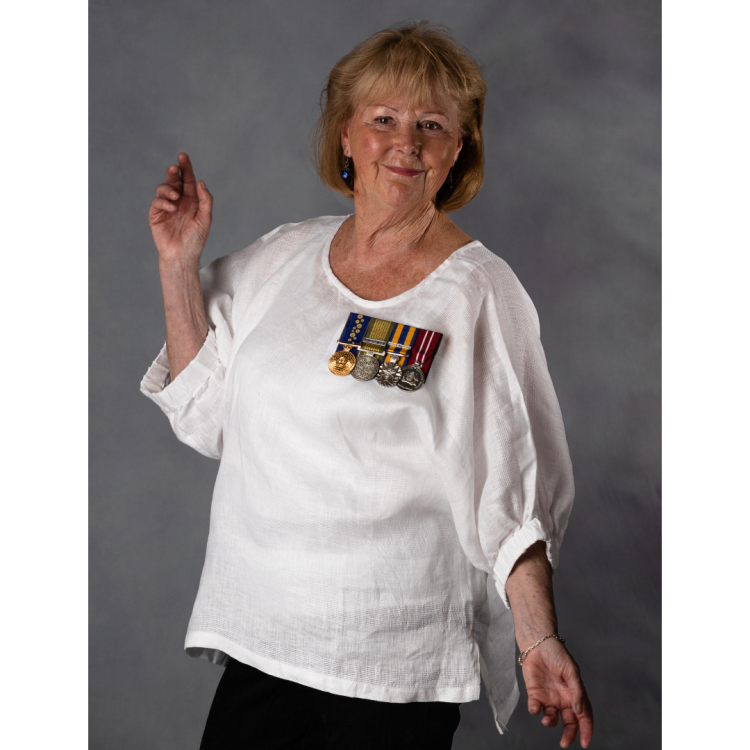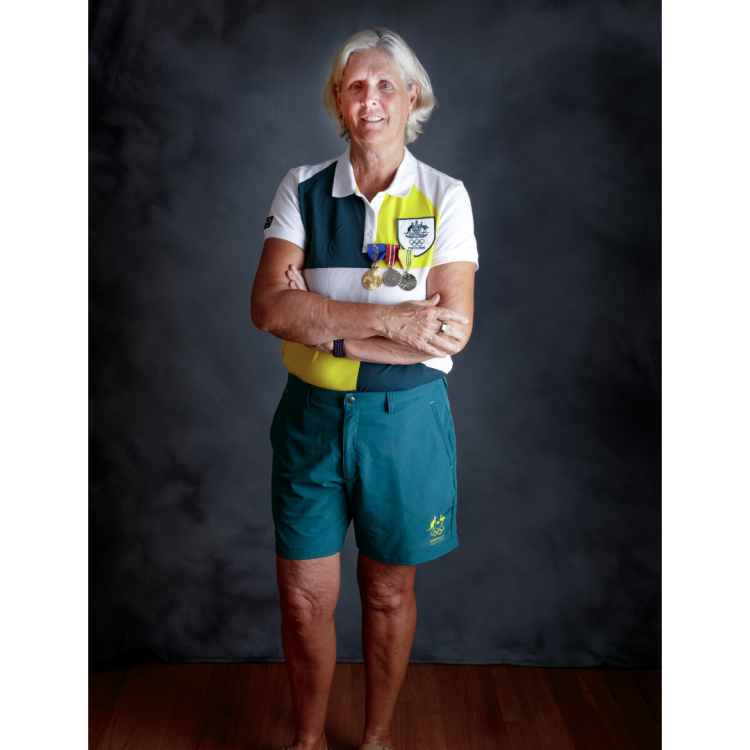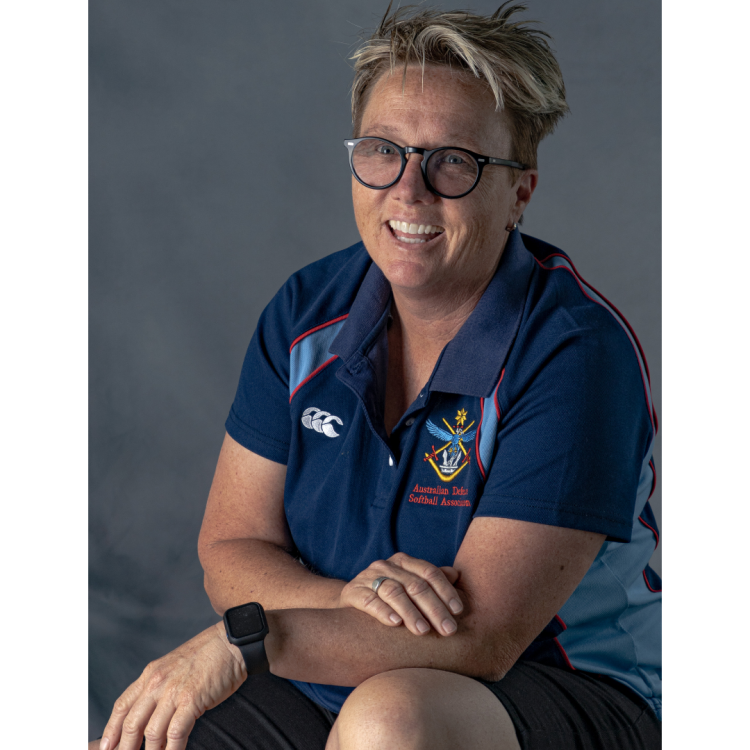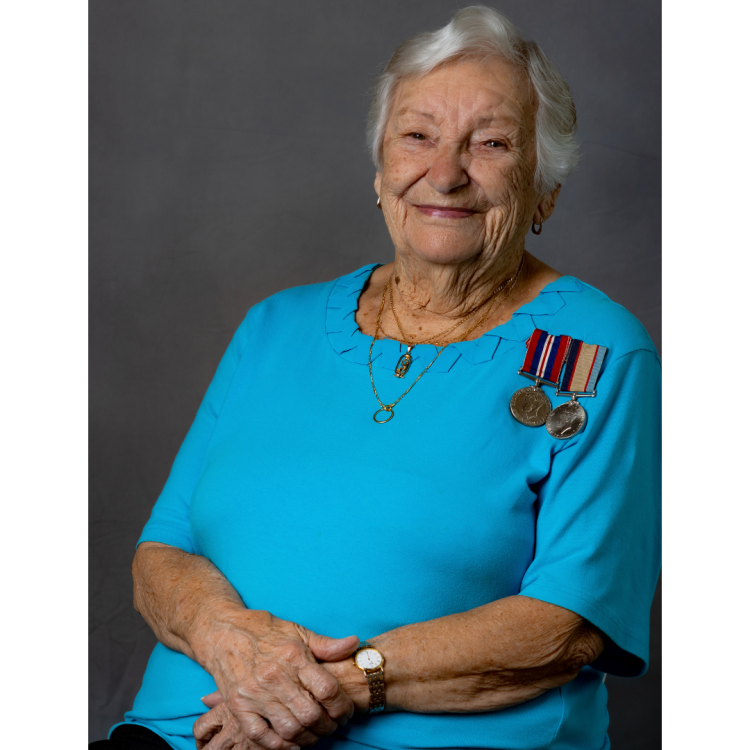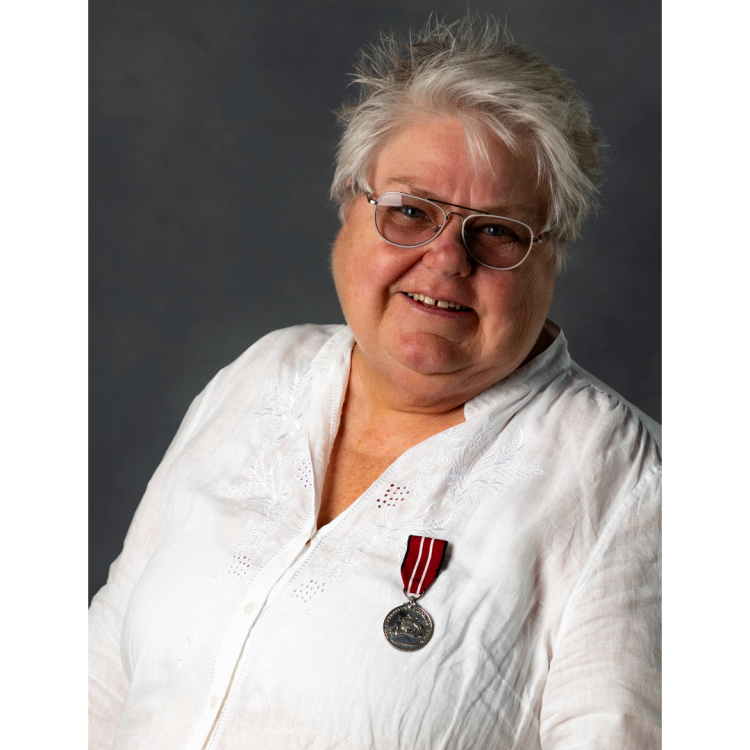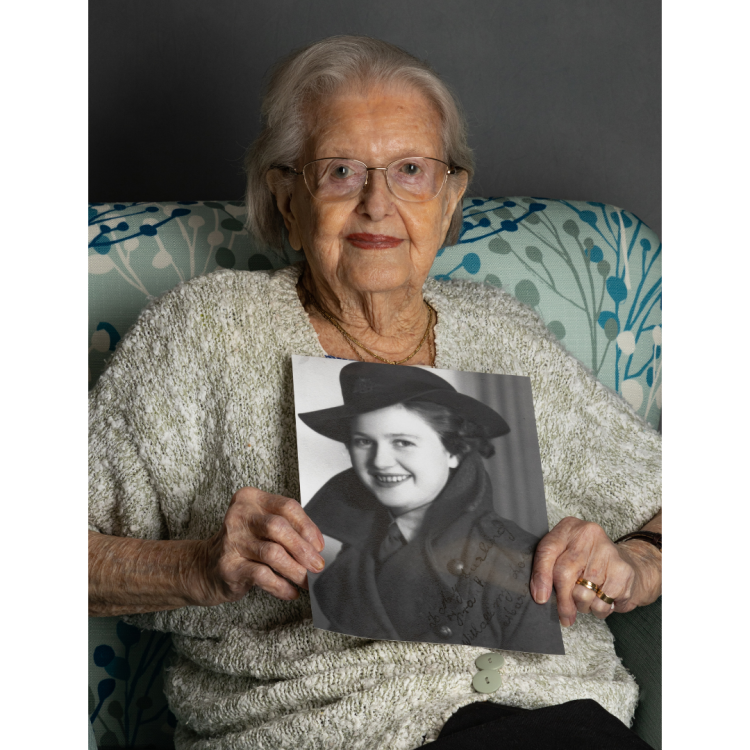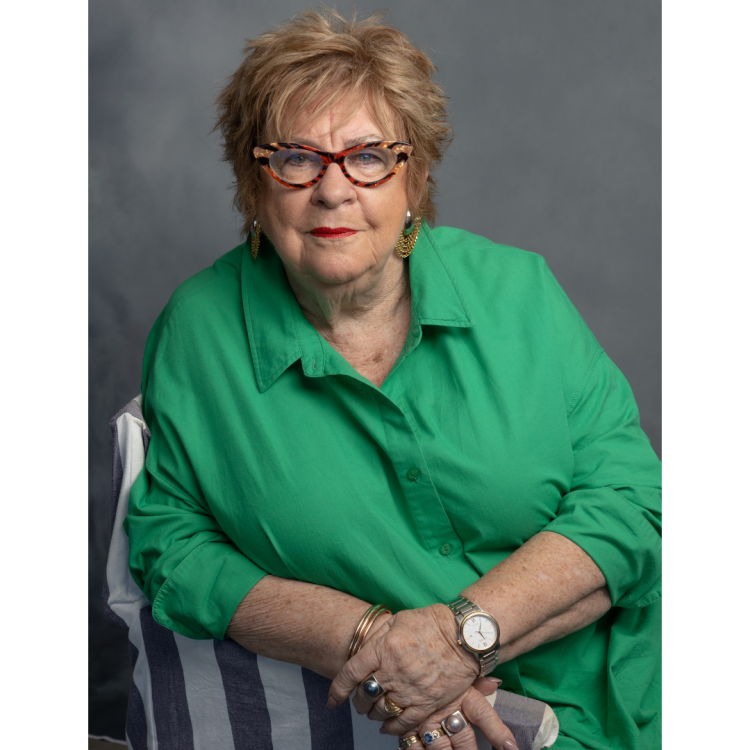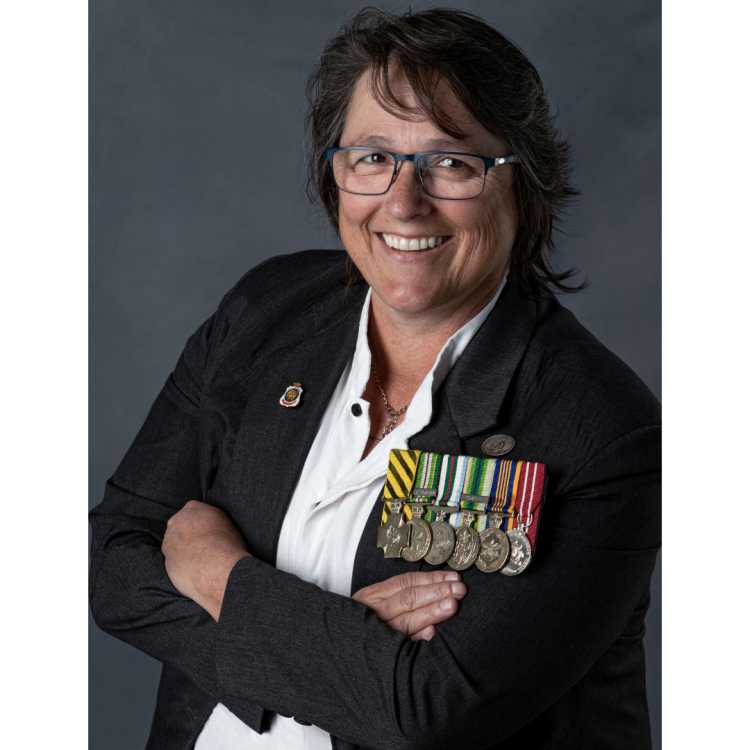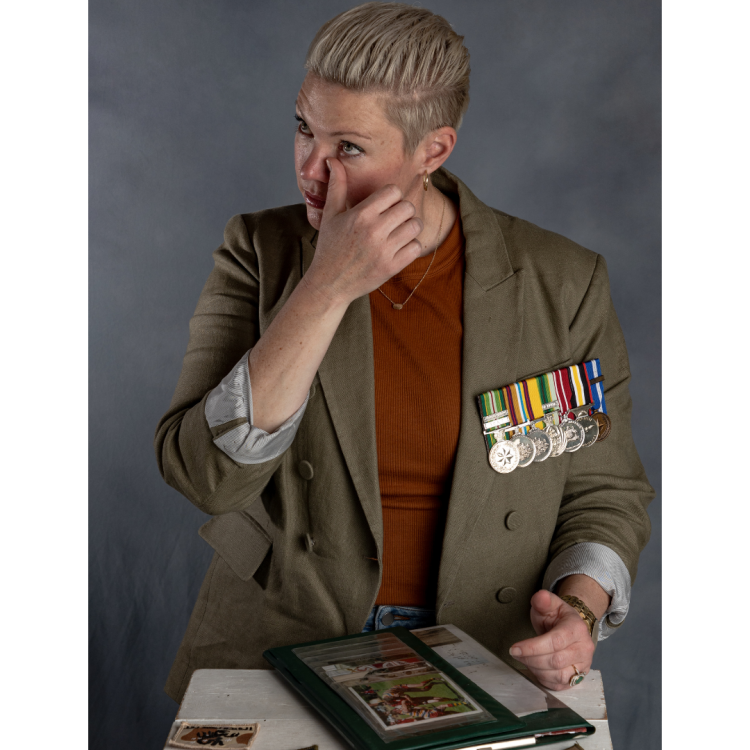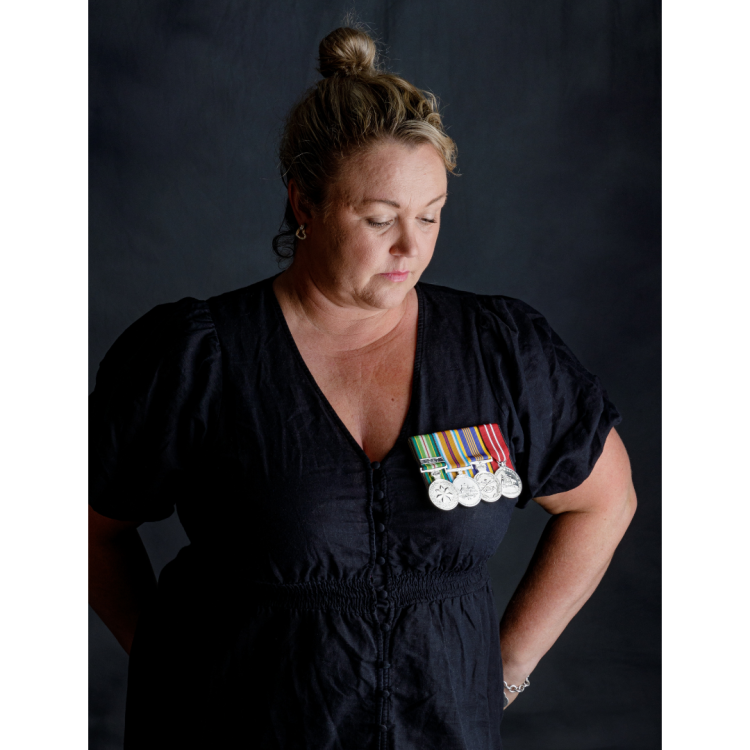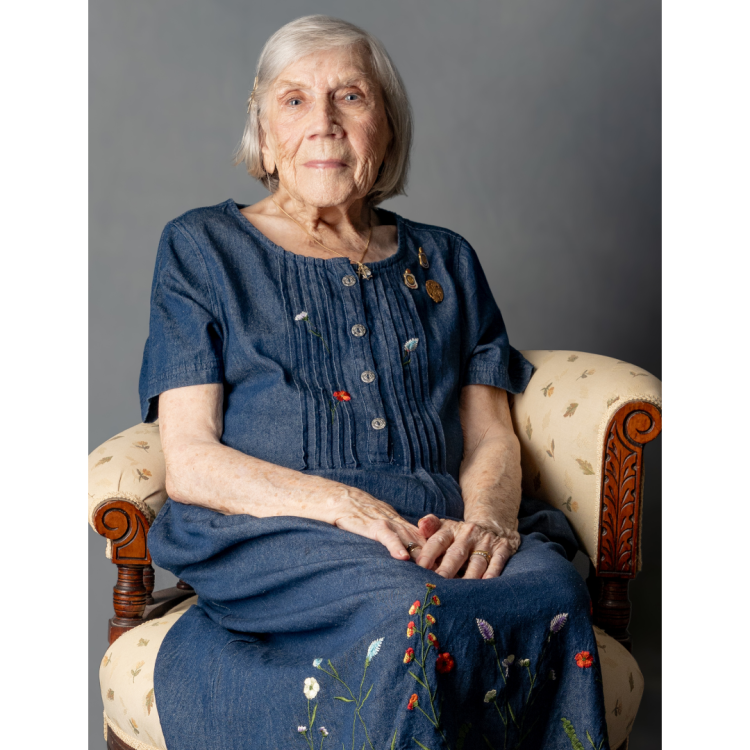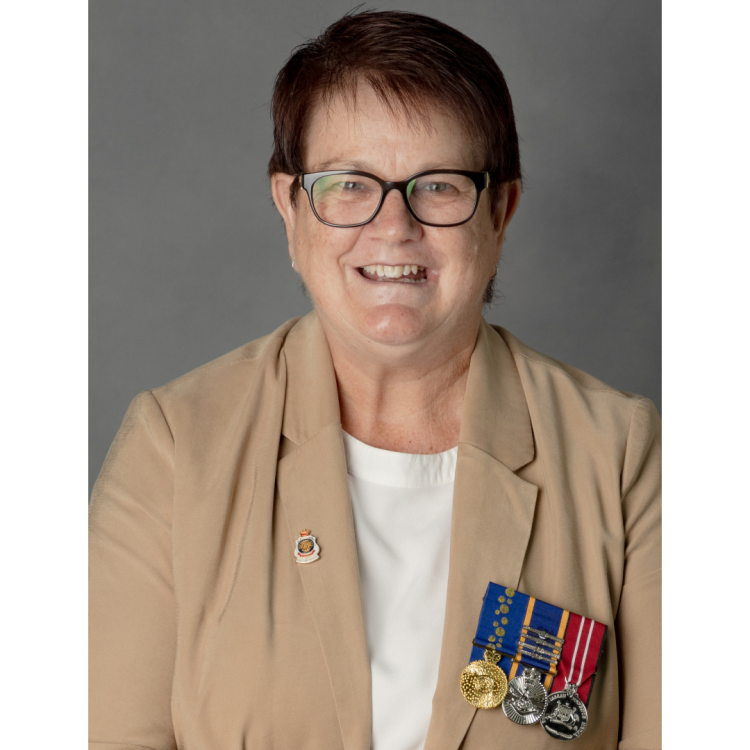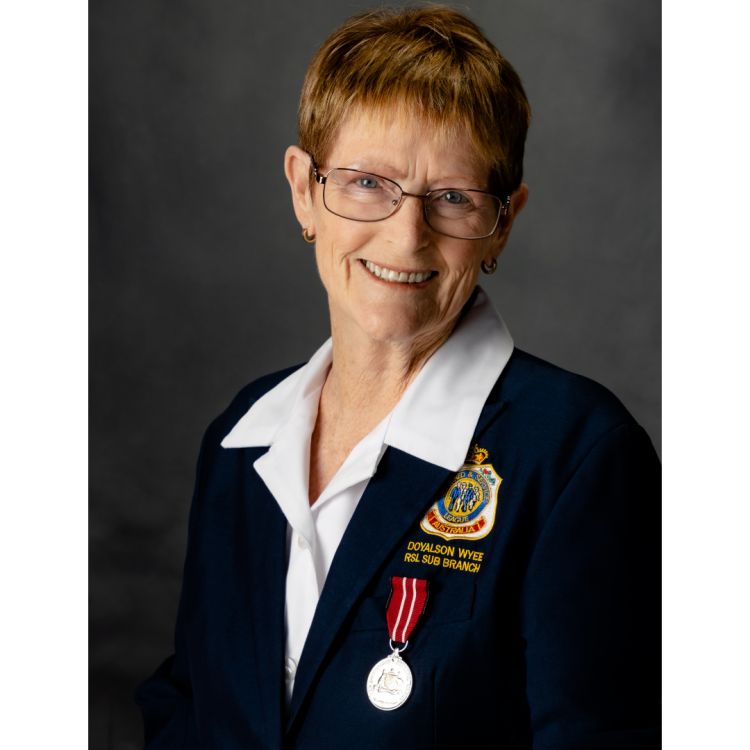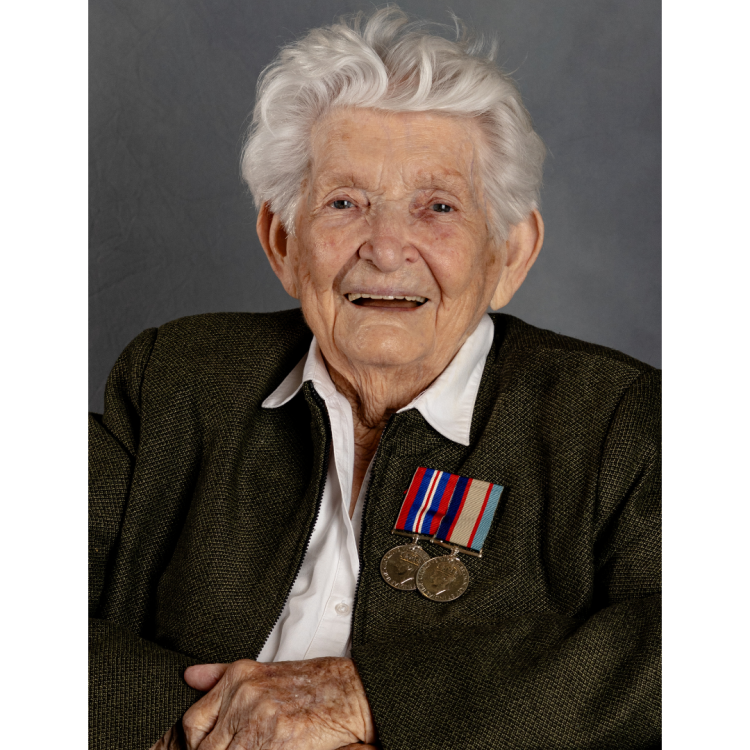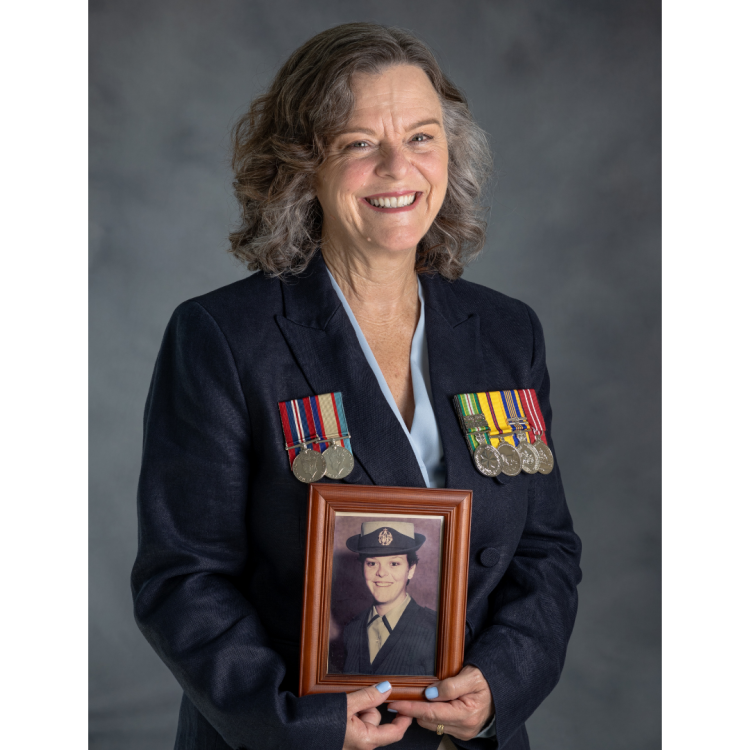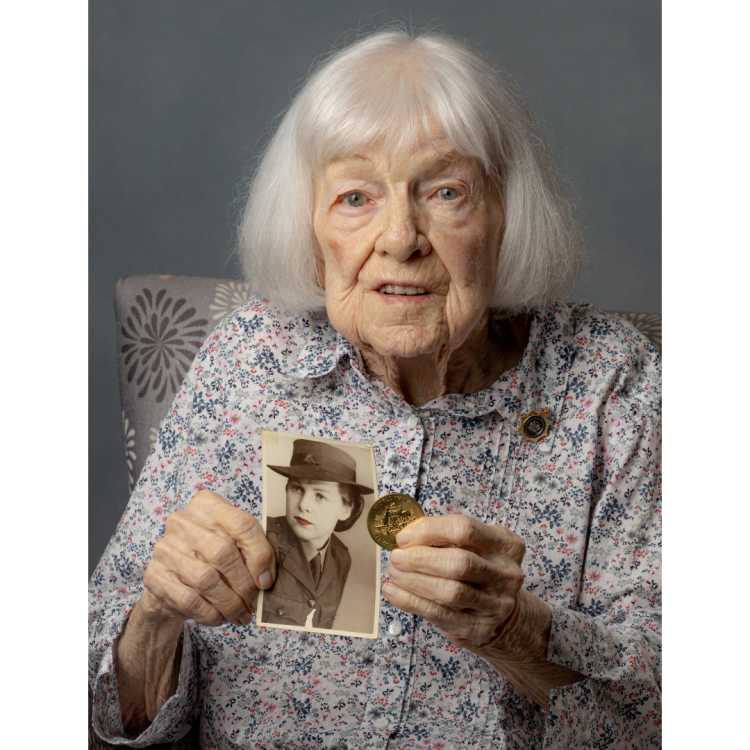The HERstory: Remembering Australia’s Military Women exhibition is artist Carla Edwards' personal thank you to the women who have served in the Australian Defence Force. The exhibition features 24 women from New South Wales whose military service spans from 1942 up to the present day.
The women served, in the Air Force, Army and Navy as well as the Australian Army Medical Women’s Service, Australian Women's Army Service, Women’s Auxiliary Australian Air Force, Women's Royal Australian Air Force, Women's Royal Australian Army Corps and the Women’s Royal Australian Naval Service.
Read the personal stories of service for each veteran via the menu below.
Audrey Powell (nee Hart)
Women’s Royal Australian Air Force (WRAAF)
"I think enlisting was an opportunity for me to ‘become myself’ and a decision I could make for myself.
I didn’t have any desire to join the Navy so I enlisted in the WRAAF. One thing I do remember, we joined because it was fun.
I did morse code and getting the feel of it was hard. But I was very good. I had to be. We had to be excellent with no mistakes and I was posted to Cootamundra [Aerodrome].
I enjoyed wearing the uniform and I looked very smart. Wearing the uniform you were a somebody."
Carol Kaiser OAM
Women’s Royal Australian Naval Service (WRANS)
"I joined the WRAN in 1969, aged 19 as a Sick Berth Attendant (nursing duties). I served 20 years and became the first female Chief Petty Officer Medical, Warrant Officer Medical and female Mess President in the Navy. My career opened the promotion chances for following female medics.
In 1988 I received an Order of Australia [under the married name of Lacey] for my efforts assisting in the development of the Navy’s Drug & Alcohol Program. I was very proud to be part of the Drug & Alcohol Program as it recognises alcoholism as an illness and gives serving members rehabilitation instead of disciplinary action.
I enjoyed my service, making long lasting friends."
Dr Deidre (Dee) Anderson AM
Royal Australian Air Force (RAAF)
"I joined the RAAF in 1975 and became the first female military Physical Training Instructor (PTI) in the world.
My job was to train the pilots and any of the crew - to make sure they are fit enough to go up and fly.
One of the difficulties I experienced as a PTI in a predominantly male world was to be taken seriously. So, whenever I had to do something physical I had to beat the boys.
In 2022 I was awarded an Order of Australia for my contribution to sport and tertiary education and that was in recognition of every person who has played a part in my journey."
Elissa Clyne
Australian Regular Army (ARA)
"I joined the Army in 1990, after having no direction in life.
Completed basic training and was recruited in the Royal Australian Corps of Transport, posting to Puckapunyal [Australian Army training facility, Seymour, Victoria].
Later I completed my Recruit Instructor Course and became a Recruit Instructor at Kapooka [Blamey Barracks, Wagga Wagga].
Obtained the rank of Sergeant and discharged from Royal Military College in 2003."
Irene (Joy) Harvey (nee Brown)
Women’s Auxiliary Australian Air Force (WAAAF)
"Having a last name of ‘Brown’, and the recruitment office going alphabetically, when I was called up I was one of the first women in NSW to be enlisted.
After training I was posted to the WAAAF training camp at Robertson near Moss Vale as a receptionist with Aircraftwomen.
In 1943 the Robertson training school closed down and I was posted to Williamtown Air Base. This was when I felt I was being an active part of the war effort.
I enjoyed my time in the service and I’ve never regretted it."
Jan-Maree Ball OAM
Royal Australian Air Force (RAAF)
Royal Australian Navy (RAN)
"I joined the Air Force when I was 19 in 1982 and served for around seven years as an Air Traffic Controller.
In 1989 I transferred to the Navy as a Communications Officer.
Being a member of the Australian Defence Force is unlike any other job.
I was very proud to wear the uniform and I will always be grateful for the people I met and the experiences I had during my 15 years of service."
Judith Walker
Women’s Royal Australian Army Corps (WRAAC)
"I came from a military background. When my grandfather found out I wanted to join one of the services he said, ‘Why do you want to do that?’
I went to see the Navy recruit officer and their enlistment was nine years and I said, ‘that was too long’. I went to the Air Force and their first enlistment was six years – that was still too long. The Army was three years or six years. I said, ‘I’ll take the three years.’ Twenty years later I’m still there!
In the course of my Army Career, I went from Engineering to Water Transportation to Aviation.
Camaraderie that lasts a lifetime makes this lifestyle perfect."
June Smith (nee Prior)
Australian Army Medical Women’s Service (AAMWS)
"In the AAMWS we weren’t nurses, not by a long shot but we were supposed to have some sort of medical training.
I enlisted [in 1942] because it was expected. Photos were everywhere, you’re constantly seeing you’re needed and they tried to persuade everybody to do something to help the war. ‘The war will be over soon. Tomorrow. The war will be over by Christmas and you need to be in it.’
I was posted to 114 Australian General Hospital in Goulburn. I was in the Orderly Room. When in Goulburn my name came up to go to New Guinea.
I was in New Guinea for 12 months and was there when peace was declared."
Kathy Rix
Women’s Royal Australian Air Force (WRAAF)
"I was 18 years old in July 1967 when I joined the WRAAF. I did ‘rookies’ [recruit school] at Edinburgh in South Australia. I was a Clerk, Equipment Accounts.
I enlisted because I was in a dead-end job and wanted to do something different. My mother was in the Air Force during the [Second] World War and absolutely loved it. I thought what a great opportunity to serve Australia and do something different.
I wish more young people would pick up the baton, join the services and experience a rewarding lifestyle."
Kim Brown
Royal Australian Navy (RAN)
"I went into the Navy as a baby at 19 years. My father was a sailor, so I followed in his footsteps in a way.
I was an Officer Steward. My first posting was on HMAS Jervis Bay as Captain’s Valet. The second ship I was posted onto was HMAS Sydney, a warship. My rank was Petty Officer.
I was one of the first Senior Sailor women to ever get posted onto a warship.
Being one of the first female Senior Sailors on HMAS Sydney was a highlight because it was historical and is now written as history."
Mary Colley (nee Reid)
Australian Women's Army Service (AWAS)
"I was born in Sydney in 1923. I was in Bondi when the Japanese bombs went over my sister’s house in 1942.
I was 20 when I enlisted and was sent to Bathurst to join a unit made up of 20 people including six women. I did lots of different jobs including equipment storage and distribution and working with military vehicles.
When you were in the Army in those days you did not have a regular job. You changed job roles depending on what needed to be done.
I am proud of my time in the Army."
Maureen Hodge (nee Miles)
Women's Royal Australian Army Corps (WRAAC)
Citizens Military Forces (CMF)
"I was in the CMF, now known as the Army Reserve. I enlisted as a Private in 1968, discharging in 1971 as Corporal. The training was the same as being in the regular Army.
Very few people know about my service. When it comes up, people say, ‘What? You were in the Army?’ In the 60s it was very unusual for a woman to go into the military.
I was in the Supply & Transport Platoon as a Driver Instructor. I loved every minute of being a soldier."
Meleisha Morrison
Australian Regular Army (ARA)
"I enlisted into the Australian Army on the second of December 1999. I enlisted because I have a family history of joining the military and I also wanted to have a career within the military.
The time I spent in the Army was just short of 15 years, around 13 years full-time service and the rest part-time service.
I was recruited into the Royal Australian Signal Corps before transferring to the Royal Australian Army Ordnance Corps as an Administration Clerk. I changed career paths and transferred into the Psychology Corps as a Psych Examiner. I had many deployments including East Timor, Kuwait, Dubai and Afghanistan."
Melinda Dagg, CSC
Royal Australian Navy (RAN)
"I enlisted in the Royal Australian Navy in 1986 and I served for 20 years ashore and in the ‘skimmer fleet’ [surface ships].
I was a cook and we served on average 700 meals a day over four mealtimes, every day. It didn't matter if it was a Saturday or Sunday, every day was a Monday for us… Pizza nights were probably the easiest because you’re feeding 200 people and you know that about 175 of them are going to have pizza.
I played a lot of sports, particularly softball while serving and met so many people from the other services.
A job’s a job but in the service it’s the people that are the difference."
Melissa Harries
Australian Regular Army (ARA)
"I was emotional as a kid thinking about what our young men do overseas. There was a big part of me that wanted to be part of something great… I was in uniform during a really busy period [2005 – 2012]. The intensity of the work while you’re overseas is high but it’s so exciting.
I spent 18 months overseas in the Middle East and East Timor. It was the making of me as a psychologist. I had to step into the discomfort, back myself and make decisions. I’ve crafted ways about how I talk about my service which is why I’m quite emotional with what we’re talking about."
Melissa Webb
Royal Australian Navy (RAN)
"I joined the Navy because I had an adventurous soul. I remember being really proud of my grandfather who served in the Army. I just knew early on that I wanted to serve my country.
I thank the work of our fore-women and the hardships and the challenges that they faced.
To be a chef in the Navy was so enjoyable because I could live my passion serving people, bringing joy to their lives. To bring joy to them through food it easily my biggest accomplishment in the Navy.
I had the most marvellous career, mostly."
Nancie Swan (nee Costello)
Australian Army Medical Women’s Service (AAMWS)
"I was born in 1923, and in 1943 my girlfriend and I enlisted. ‘Rookies’ [recruit school] was in the gully of Bacchus Marsh.
Some nights you slept under your greatcoat and sometimes you slept wearing it. It was cold on the camp stretchers. When I wasn't working I was eating, sleeping, reading, exercising or marching. We did a lot of marching!
I was posted to the switchboard at 13th Australian General Medical Hospital in Heidelberg. I was transferred to Concord in the first week of peace in September 1945.
During these times I met some wonderful people."
Patsy Edwards OAM (nee Eaton)
Women's Royal Australian Army Corps (WRAAC) Reserves
Women’s Royal Australian Naval Service (WRANS)
"I was doomed to go into military life. My family history goes back to the Boer War, if not earlier.
I did two years with the WRAAC and was finally able to get into the WRANS. I was in the third class that accepted female Electronic Technician Communications. But I got married so left and stayed with the WRANS Reserves. I was the first female in Tasmania to be able to join the Navy Reserve when women were allowed to join.
I had so many fun times and the best was at HMAS Huon in Hobart. My heart was Navy."
Rhonda Whiteman (nee McKenzie)
Women's Royal Australian Air Force (WRAAF)
"I went into the WRAAF to do nursing [enlisted 1967].
My parents had to sign my enlistment papers and Dad reluctantly signed. He didn’t think I was serious.
I was the only Medic at Frognall [wireless telegraph station] most of the time, I had to be available while the cadets were on base especially when they were playing sport.
I spent all my time in the WRAAF wearing ‘drabs’ - a khaki, light-brown cotton uniform which was horrible and it took a whole bottle of zippy starch to launder three drabs.
I have no regrets joining the WRAAF and I really did enjoy it."
Rita Anderson (nee Killiby)
Australian Women's Army Service (AWAS)
"My girlfriends were enlisting so I did too [in 1942]. We chose the Army because that’s the one you could get in to quickly. I was in for four and a half years.
The men were thorough gentlemen to us twelve girls in the unit.
When they announced Armistice Day every unit jumped and ran. I was a catholic so I rushed to St Mary’s Cathedral and it was full of people kneeling, even the footpath was full. It was very exciting and wonderful. Everybody was throwing their hats in the air. You’ve got no idea."
Robyn Harrison
Women's Royal Australian Air Force (WRAAF)
Royal Australian Air Force (RAAF)
"I had two enlistments with a seven-year gap between them. Choices for females in the 70s were limited, at 15 I was told I couldn’t become an apprentice mechanic. I waited and at 19 enlisted and became a Steward.
I was discharged because I was pregnant but I knew my career wasn’t over. I applied to enlist in the RAAF in 1979 but was refused. I objected and this continued until late 1980. I then took my case to the Human Rights Commission and in late 1981 I was invited to enlist in the RAAF.
It opened the door for women to start doing previously exclusive men’s musterings. I’ve been an advocate for these people and changes happened."
Tracey Molloy
Royal Australian Navy (RAN)
Women's Royal Australian Naval Service (WRANS)
"The primary reason I joined the Navy was because I wanted to do something different. In fact I was pretty wild when I went in. My training taught me discipline, but the structure also rewarded me.
The branch I started in was then known as Radar Plotter, a very small branch with very few women.
I worked predominately in the area of tactical training, firstly as a member of the Solartron Radar Simulator, where we provided training to anti-submarine aircraft controllers.
I really enjoyed what I did and it was very very rewarding.
My service in the Navy was one of the best decisions I’ve ever made in my life."
Tracey Thom
Royal Australian Air Force (RAAF)
"I joined the Air Force at the age of 17 in 1984, that’s 40 years ago. I’ve done two stints of service with 14 years between.
My grandmother was in the Air Force, and she was really proud of her service. I loved how proud she was.
When I very first joined I was what was called a General Hand and when I discharged I was a Clerk.
I loved my posting to 5 Aviation [5th Aviation Regiment]. I had autonomy and got to fly in Black Hawk and Iroquois helicopters. Who wouldn’t love that as an option when you go to work?"
Veronica Cameron (nee Lane)
Australian Army Medical Women’s Service (AAMWS)
Australian Women’s Land Army (AWLA)
"I was born in 1922 and brought up in the suburbs of Sydney.
At 18 I was working for Carmichaels, a factory in Auburn that used to make stoves. During the [Second World] war the factories were turned into munitions factories.
I was one of 20 women locked up in sections of the factory so we wouldn’t talk about what we did. Each section had a portion of a machine gun to inspect.
My job was to test the firing pins of the machine guns by banging them with something and hoped they fired properly. All very crude. We worked 16 hours a day."
Article: Role of women in Australia’s military history
By Brad Manera
The story of the role of the military in Australian history predates European settlement however apart from the challenging, often heartbreaking, task of mothers, wives and sweethearts of Australian men who have gone to war the role of women in the uniformed services is very recent.
New South Wales was among the first of the Australian colonies to create a female military nursing service. Qualified female nurses from this colony saw active service in South Africa during the Second Anglo-Boer War (1899-1902) however they were employed in base hospitals and convalescent wards. The sound of gunfire was something they only read about.
During the Great War (1914-18) the Australian Imperial Force again despatched female nurses to war. Again, they were relegated to hospitals many kilometres behind the front or to care for the sick and wounded on troopships bringing the surviving casualties home.
Dissatisfied with this restricted employment and searching for more active service many Australian women paid their own way to war and served in foreign armies but usually in roles connected with the medical corps.
At the outbreak of the Second World War in 1939 the pattern repeated itself but as the fighting approached our shores and the government put the nation on a total war footing the instinctively exclusivist and conservative administration realised that women could fill vital roles that would free up manpower for the fighting units. The navy, army and air force all formed women’s auxiliaries. Women became transport drivers, communicators, sea, land and air traffic controllers. They crewed searchlight anti-aircraft batteries, deciphered code and operated heavy electrical and mechanical equipment among many other essential tasks.
With peace the military hierarchy expected these trained and experienced veterans to return to the kitchen. It did not take long before the fledgling Australian Regular Army and the other services realised that there was an ongoing role for women in uniform.
The post war world saw the formation of units created exclusively for women like the Women’s Royal Australian Naval Service, the Women’s Royal Australian Army Corps and the Women’s Royal Australian Air Force. These women were allowed to deploy to the Korean War (1950-53), Emergencies and Confrontation in South East Asia and the Vietnam War (1962-75) but they still suffered under regulations like insisting on discharge if the female soldier married.
In more recent decades these units were disbanded.
Gradually women have overcome deep seated prejudice and become more thoroughly integrated into all branches of what is now the Australian Defence Force. No longer restricted to logistic and support roles, in the 21st century, women pilots are serving in our front-line fighter squadrons, infantry battalions, surface warships and submarines. They have seen active service in the Middle East, Afghanistan and on hazardous peace-keeping deployments. Women occupy senior command positions as Rear Admirals, Major Generals, a Lieutenant General and Air Vice Marshals.
Current serving personnel owe their freedoms to the tenacity and endurance of the women of their mother’s and grandmother’s generations who have worn a uniform in the past.
This exhibition is a tribute to those women who have served and demonstrated that they have played a vital part in the ongoing Anzac tradition.


